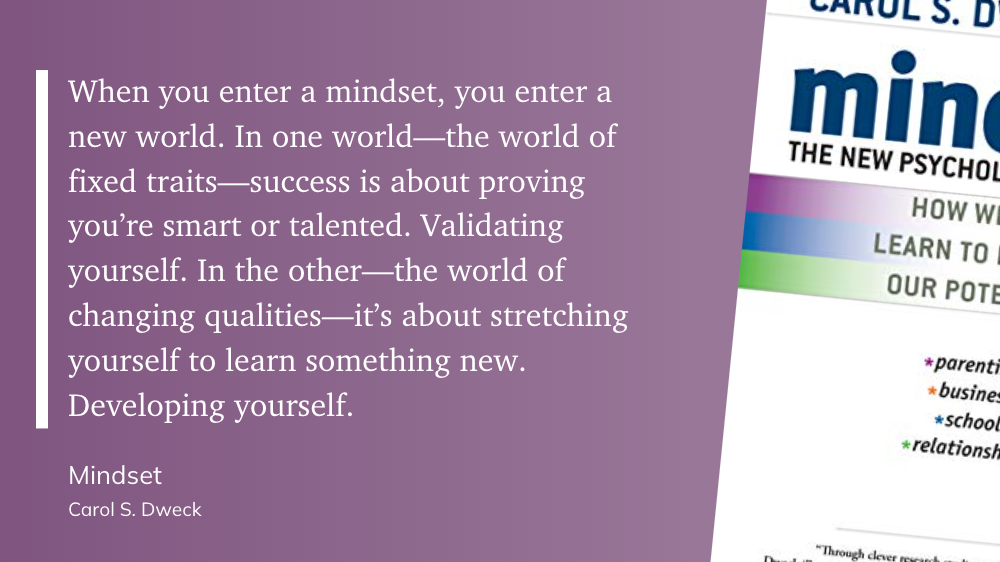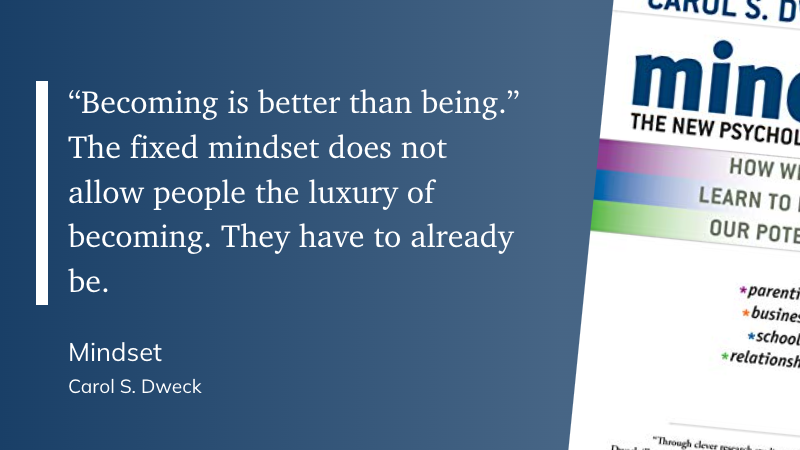
When it comes to personal growth and learning, the difference between a growth mindset and a fixed mindset is huge. In simplest terms, a growth mindset is when you believe that you can improve your skills with practice and hard work. A fixed mindset is when you think that your abilities are set in stone and can’t really be changed.
These two ways of thinking shape how you feel about your abilities, how you see challenges, and how you deal with setbacks. For instance, if you have a growth mindset, you might see a challenge as a way to learn and grow, but if you have a fixed mindset, you might see the same challenge as evidence of your limitations. And if you face a setback, someone with a growth mindset might use it as a chance to reflect and improve, while someone with a fixed mindset might see it as proof that they’re not good enough.
It’s important to know about these mindsets and how they affect our lives because they can impact how motivated we are, how we handle obstacles, and how successful we are. If we focus on having a growth mindset and believe that we can get better with practice, we can achieve more and overcome challenges more easily.

Exploring The Fixed Mindset
A fixed mindset is grounded in the belief that our abilities are innate and unchangeable. This can lead to a self-fulfilling prophecy where people with a fixed mindset believe that their talents and skills are predetermined, making them less likely to take risks and try new things. This can stifle personal growth and development, as individuals with a fixed mindset may avoid challenges for fear of failure. Instead of viewing setbacks as learning opportunities, they may perceive them as personal deficiencies. It’s important to recognize the limitations of a fixed mindset and how detrimental that mindset can be to your personal success.
The Growth Mindset Paradigm
Contrarily, a growth mindset propels the idea that abilities and intelligence can be developed with effort, learning, and persistence. Carol Dweck first popularized the idea of a growth mindset in her seminal work, Mindset. It’s about viewing challenges as opportunities to learn, grow, and improve. Instead of avoiding difficult tasks, individuals with a growth mindset embrace them, understanding that effort is a critical path to mastery.
The Underlying Neuroscience
The concept of neuroplasticity, which is the ability of our brains to reorganize and form new connections, supports the growth mindset theory. This has significant implications in various areas of our lives, such as education, personal growth, and professional development. In the context of education, understanding the potential of our brain’s neuroplasticity can lead to designing teaching practices that help students develop a growth mindset. Educators can encourage students to embrace challenges as opportunities for growth, which can foster learning and innovation.
Teachers who adopt a growth mindset can empower their students by providing them with the tools and support they need to take charge of their own learning. By fostering student agency, teachers can help to create a more collaborative and dynamic learning environment, where students are encouraged to take risks and explore new ideas. The growth mindset can also influence personal growth through developing habits and mindsets that facilitate neuroplasticity, such as engaging in novel experiences or practicing mindfulness.
Finally, school leaders can create a culture of learning and development by promoting a growth mindset, which can lead to improved performance and innovation. By recognizing that the mindsets of students, teachers, and school leaders can be developed through dedication and hard work, we can tap into our limitless potential and foster personal and professional growth.
Comparing Fixed and Growth Mindsets
While a fixed mindset can lead to stagnation and a fear-based approach to life, a growth mindset promotes continuous improvement, resilience, and a love for learning. The comparison between these two mindsets can be seen in how they respond to challenges, deal with criticism, and approach success.

Examples of Fixed Mindset Students:
- Elementary School: A student in third grade named Michael was hesitant to try new activities because he was afraid of making mistakes. His teacher noticed that he often gave up when things got difficult and encouraged him to keep trying. Michael responded, “I’m just not good at this. I don’t want to keep doing it.”
- Middle School: A student in seventh grade named Emily struggled with math. She had always believed that she just wasn’t good at it and that she would never understand. Her teacher noticed that Emily often shut down during math class and rarely asked questions. When her teacher tried to encourage her and tell her that she was capable of understanding math, Emily responded, “I’m just not smart enough for this. It’s too hard.”
- High School: A student in eleventh grade named John was interested in playing the guitar but was hesitant to join the school band. He believed that he wasn’t musically talented and that he would embarrass himself. When his music teacher suggested that he try out for the band, John responded, “I’m not good enough. I’ll just mess up and embarrass myself.”
- Nottingham, James A. (Author)
- English (Publication Language)
- 224 Pages – 07/13/2018 (Publication Date) – Corwin (Publisher)
Examples of Growth Mindset Students:
- Elementary School: A student in second grade named Sarah struggled with reading. Her teacher encouraged her to keep practicing, telling her, “It’s okay to make mistakes, that’s how we learn!” Sarah began to see reading as a challenge to overcome and eventually became an avid reader.
- Middle School: A student in eighth grade named Alex was struggling in math class. His teacher noticed that he was becoming discouraged and decided to work with him one-on-one after class. She encouraged him to view mistakes as opportunities to learn and to keep trying. Alex’s hard work and persistence paid off, and he eventually became one of the top students in the class.
- High School: A student in twelfth grade named Maria was nervous about taking the SATs. Her guidance counselor reminded her that the test was just one step in her college application process and that many resources were available to help her prepare. Maria embraced the challenge, seeking out study materials and practice tests. Maria scored higher than she had expected and was accepted into her top-choice university.
- Brock, Annie (Author)
- English (Publication Language)
- 248 Pages – 09/16/2022 (Publication Date) – Ulysses Press (Publisher)
Harnessing the Power of a Growth Mindset
Adopting a growth mindset is a valuable approach that can significantly improve student outcomes and teacher practice. It encourages students to embrace challenges as opportunities to learn and grow, which is a vital aspect of developing problem-solving skills and promoting a healthy approach to failure. In addition to this, adopting a growth mindset also provides a framework for teachers to promote student agency and authentic learning experiences, which can help to create a more dynamic and engaging learning environment.
It is important to recognize that a growth mindset is not just about intelligence or natural talent. Instead, it is about understanding that abilities and intelligence can be developed through dedication and hard work. By adopting this approach, students and teachers alike can tap into their limitless potential and set the foundation for continuous personal and professional development.
One of the key benefits of adopting a growth mindset is that it can promote a more positive attitude toward learning. When students are encouraged to view challenges as opportunities to learn and grow, they are more likely to take an active role in their own learning. This can lead to increased motivation, engagement, and a greater sense of ownership over the learning process.
Similarly, teachers who adopt a growth mindset can help to empower their students by providing them with the tools and support they need to take charge of their own learning. By fostering student agency, teachers can help to create a more collaborative and dynamic learning environment, where students are encouraged to take risks and explore new ideas.
- Hardcover Book
- Dweck, Carol S. (Author)
- English (Publication Language)
- 320 Pages – 02/28/2006 (Publication Date) – Random House (Publisher)
Shifting from a Fixed to Growth Mindset
Adopting a growth mindset is not a destination, but a journey. It involves recognizing and challenging our fixed mindset beliefs, embracing challenges, persisting in the face of setbacks, and understanding that effort is the path to mastery. This shift fuels our potential, ignites our creativity, and empowers us to achieve our goals.
In conclusion, understanding and implementing the growth mindset in our lives can empower us to become better learners, innovative thinkers, and proactive individuals. By recognizing that our abilities can be developed through dedication and hard work, we can truly tap into our limitless potential and foster personal and professional growth
Last update on 2025-12-19 / Affiliate links / Images from Amazon Product Advertising API


